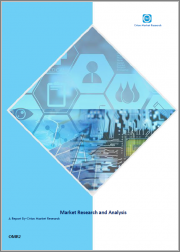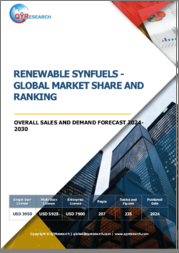
|
시장보고서
상품코드
1380429
세계의 합성 연료 시장(2023-2030년)Global Synthetic Fuel Market 2023-2030 |
||||||
합성 연료 시장은 예측 기간(2023-2030년) 동안 CAGR 22.8%의 성장률을 보일 것으로 예상됩니다. 합성 연료는 합성 연료라고도 하며, 수소와 탄소 또는 탄화수소로 만든 액체 또는 기체 연료입니다. 합성 연료는 산업 공정이나 대기에서 배출되는 탄소를 회수하여 물이나 바이오매스와 같은 재생 가능한 자원에서 얻은 수소와 결합하여 제조됩니다. 합성연료는 엔진이나 인프라를 개조하지 않고도 화석연료와 동일하게 사용할 수 있습니다. 시장 성장을 뒷받침하는 주요 요인으로는 환경 문제에 대한 관심 증가와 청정 에너지원에 대한 요구가 있습니다. 탄소배출량 증가로 인해 세계적으로 전기자동차(EV), 수소연료, 바이오연료, 합성연료 또는 전자연료와 같은 대안으로 전환하는 움직임이 가속화되고 있습니다. 합성 연료는 탄소 중립적이며 환경 보호에 기여하는 친환경적인 단계입니다. 예를 들어, 2022년 12월, 포르쉐와 여러 파트너들은 기존 내연기관 자동차의 가솔린을 대체하기 위해 기후 변화에 영향을 받지 않는 'e-연료'를 생산하기 시작했습니다.
부문별 전망
운수산업이 합성연료 시장에서 큰 비중을 차지할 것으로 예상됨
합성 연료유형별로는 운송 산업이 시장에서 큰 비중을 차지할 것으로 예상됩니다. 환경 유해물질 배출량이 급격히 증가하면서 운송업계가 합성연료를 선택하는 원동력이 되고 있습니다. 국제에너지기구(IEA)에 따르면 2022년 CO2 배출량은 여객 및 화물 운송 활동의 회복으로 전년 대비 3% 증가할 것으로 예상됩니다. 운송 부문의 배출량은 1990년부터 2022년까지 연평균 1.7% 증가하여 산업 부문을 제외한 다른 어떤 최종 사용 부문보다 빠르게 증가하고 있습니다. 이에 따라 CO2 배출량 감축을 위한 정책 및 규제 도입이 크게 증가하고 있습니다. 국제통화기금(IMF)에 따르면, CO2 배출량 감축을 위한 매우 효과적인 정책은 화석연료 공급망 업스트림에서 각 연료의 탄소 함량에 비례하여 적용되는 탄소세다(하류에서 CCS를 통해 배출량을 회수할 경우 환급). 이 세제는 이후 연료 연소로 인한 CO2 배출 가능성을 완전히 커버합니다.
또한 시장 리더들은 투자와 협력을 확대하여 기술 발전에 집중하고 있습니다. 예를 들어, 2023년 4월 도요타와 엑손모빌은 저탄소 합성 연료 개발에 협력하여 일반 휘발유에 비해 온실 가스 배출량을 75%까지 줄일 수 있습니다.
지역별 전망
세계 합성연료 시장은 북미(미국, 캐나다), 유럽(영국, 이탈리아, 스페인, 독일, 프랑스, 기타 유럽), 아시아태평양(인도, 중국, 일본, 한국, 기타 아시아 지역), 기타 지역(중동 및 아프리카, 라틴아메리카) 등 지역별로 세분화되어 있습니다. 구분됩니다. 그 중에서도 유럽은 자동차, 항공, 산업 등 다양한 최종 사용자 산업이 존재하기 때문에 시장에서 상당한 점유율을 차지할 것으로 예상됩니다. 또한, 이 지역은 엄격한 환경 규제를 시행하고 있으며, 이는 합성 연료와 같은 지속 가능한 솔루션에 대한 수요를 촉진하고 있습니다. 예를 들어, EU는 2023년 10월 유럽 항공기 운항사와 연료 공급업체에 법적 확실성을 제공하고, EU 전역의 공정한 경쟁 조건을 보장하며, 지속 가능한 항공 연료(SAF) 생산을 촉진하여 항공 분야의 탄소 발자국을 줄이기 위한 ReFuelEU 항공 이니셔티브를 발표했습니다. 발표했습니다.
아시아태평양, 세계 합성연료 시장에서 큰 성장 기대
아시아태평양은 세계에서 가장 인구가 많은 지역으로 세계 인구의 약 60%를 차지합니다. 인구 증가와 함께 급속한 산업화, 자동차 산업의 성장, 항공 여행 증가 등으로 인해 이 지역의 탄소 배출량도 크게 증가하고 있습니다. 이러한 문제를 완화하기 위해 지역 경제는 합성 연료와 지속 가능한 연료의 사용을 촉진하고 정책과 규제를 도입하여 CO2 배출량을 줄이는 데 주력하고 있습니다. 또한, 이 지역에서는 합성연료 시장 성장에 도움이 되는 투자 및 기업 간 협력이 증가하고 있습니다. 예를 들어, 2023년 7월, 지속 가능한 항공 연료(SAF) 생산 설비를 개발하는 DG Fuels, LLC(DGF)는 일본 기업 2곳과 투자 계약을 체결했습니다. Abinor & Co, Ltd와 센도 부동산 주식회사, 그리고 익명의 투자자의 투자로 DGF는 현재 모회사 수준의 개발 자본의 최종 라운드의 최소 투자 목표를 초과했습니다. 이 자본은 현재 진행 중인 FEL3 및 관련 비용을 포함하여 최종 투자 결정(FID)까지 필요한 나머지 비용을 충당할 예정입니다. 또한 2022년 4월 일본 정부 산하 신에너지 및 산업기술종합개발기구(NEDO)는 이산화탄소(CO2) 배출량이 적은 합성연료 등 신연료 개발을 지원하기 위해 8억 9,200만 달러를 배정했습니다. 이 자금 지원은 세계 5위의 CO2 배출국인 일본이 2050년까지 탄소중립을 달성할 수 있도록 청정에너지와 기술 개발을 촉진하기 위해 설립된 156억 달러 규모의 녹색혁신기금의 일환입니다.
목차
제1장 보고서 개요
- 업계 현황 분석과 성장 가능성 전망
- 조사 방법과 툴
- 시장 내역
- 부문별
- 지역별
제2장 시장 개요와 인사이트
- 조사 범위
- 애널리스트 인사이트와 현재 시장 동향
- 주요 조사 결과
- 추천 사항
- 결론
제3장 경쟁 구도
- 주요 기업 분석
- Exxon Mobil Corp.
- 개요
- 재무 분석
- SWOT 분석
- 최근 동향
- Reliance Industries Ltd.
- 기업 개요
- 재무 분석
- SWOT 분석
- 최근 동향
- Robert Bosch GmbH
- 개요
- 재무 분석
- SWOT 분석
- 최근 동향
- Sasol Ltd.
- 개요
- 재무 분석
- SWOT 분석
- 최근 동향
- 주요 전략 분석
제4장 시장 세분화
- 세계의 합성 연료 시장 : 원료별
- 석탄
- 천연가스
- 바이오매스
- 세계의 합성 연료 시장 : 유형별
- Coal To Liquids(CTL)
- Biomass To Liquids(BTL)
- Gas To Liquids(GTL)
- 셰일오일
- 초중질유
- 세계의 합성 연료 시장 : 용도별
- 운송
- 항공
- 발전
- 산업
제5장 지역 분석
- 북미
- 미국
- 캐나다
- 유럽
- 영국
- 독일
- 이탈리아
- 스페인
- 프랑스
- 기타 유럽
- 아시아태평양
- 중국
- 인도
- 일본
- 한국
- 기타 아시아태평양
- 세계 기타 지역
제6장 기업 개요
- Air Products and Chemicals, Inc.
- Carbon Engineering Ltd.
- Gevo, Inc.
- INERATEC GmbH
- Occidental Petroleum Corporation
- johnson Matthey Plc
- Raven SR, Inc.
- Red Rock Biofuels
- Rentech, Inc.
- Repsol
- Royal Dutch Shell Plc.
- SG Preston Company
- Sunfire GmbH
- Swedish Biofuels
- Topsoe A/S
- TotalEnergies SE
- Virent, Inc.
Title: Global Synthetic Fuel Market Size, Share & Trends Analysis Report by Raw Material (Coal, Natural Gas, and Biomass), by Type (Coal-to-Liquid (CTL), Biomass-to-Liquid (BTL), Gas-to-Liquid (GTL), Shale Oil, and Extra-Heavy Oil), and by Application (Transportation, Aviation, Power Generation, and Industrial)Forecast Period (2023-2030).
The synthetic fuel market is anticipated to grow at a CAGR of 22.8% during the Forecast Period (2023-2030). Synthetic fuels, also known as synfuels, are liquid or gaseous fuels made from hydrogen and carbon, or hydrocarbons. They are produced by capturing carbon emissions from industrial processes or the atmosphere and then combining the carbon with hydrogen from renewable sources such as water or biomass. Synthetic fuels can be used in the same way as fossil fuels, without any modifications to engines or infrastructure. Primary factors supporting the market growth includes the rising environmental concerns and the requirement for cleaner energy sources. The increasing carbon footprint has urged the globe to switch over to alternative options like electric vehicles (EVs), hydrogen fuels, biofuels and synthetic or e-fuels. Synthetic fuels are carbon neutral thus a greener step contributing to saving the environment. For instance, in December 2022, Porsche and several partners have started production of a climate neutral "e-fuel" aimed at replacing gasoline in vehicles with traditional internal combustion engines.
Segmental Outlook
The global synthetic fuel market is segmented by raw material, type, and application. Based on raw materials, the market is sub-segmented into coal, natural gas, and biomass. Based on type, the market is sub-segmented into CTL, BTL, GTL, shale oil, and extra-heavy oil. Based on application, the market is sub-segmented into transportation, aviation, power generation, and industrial applications. Among the applications, aviation sub-segment is anticipated to hold a significant share of the market, owing to the rising demand for synthetic fuel. According to the International Energy Agency (IEA), in 2022, aviation was responsible for 2% of all global energy-related CO2 emissions, which is a higher growth rate compared to rail, road, or shipping sectors. Further, post-COVID-19 pandemic, aviation emissions in 2022 reached almost 800 Mt CO2, which is about 80% of pre-pandemic levels. To reduce CO2 emissions, the aviation industry is focusing on technological advancements and investments in sustainable solutions. For instance, in June 2023, Amadeus invested in CAPHENIA, a German renewable energy start-up that will begin producing fuels from synthetic gas by 2024.
Transportation Industry is Anticipated to Hold a Prominent Share of the Synthetic Fuel Market
Among the types, the transportation sub-segment is anticipated to hold a prominent share of the market. Exponentially rising emission of hazardous pollutants in the environment is the propelling transportation industry to opt for synthetic fuels. According to the International Energy Agency (IEA), in 2022, CO2 emissions increased by 3% compared to the previous year, due to the rebound in passenger and cargo transport activity. Transport emissions have grown faster than any other end-use sector except for industry, at an annual average rate of 1.7% from 1990 to 2022. Thus, the segment has witnessed a considerable increase in the introduction of policies and regulations to reduce CO2 emissions. As per the International Monetary Fund (IMF), A highly effective policy for reducing CO2 emissions is a carbon tax applied upstream in the fossil fuel supply chain in proportion to the carbon content of each fuel (with refunds for any downstream capture of emissions by CCS). This tax system fully covers potential releases of CO2 from later fuel combustion.
Additionally, the market leaders are also focusing on technological advancements by increasing investments and collaboration. For instance, in April 2023, Toyota and Exxon Mobil collaborated to develop low-carbon synthetic fuels, which could cut as much as 75 % in greenhouse gas emissions compared with regular petrol.
Regional Outlook
The global synthetic fuel market is further segmented based on geography including North America (the US, and Canada), Europe (UK, Italy, Spain, Germany, France, and the Rest of Europe), Asia-Pacific (India, China, Japan, South Korea, and Rest of Asia), and the Rest of the World (the Middle East & Africa, and Latin America). Among these, the European region is expected to hold a considerable share of the market owing to the wide presence of end-user industries such as automobile, aviation, and industrial sectors. Additionally, the region has witnessed an implementation of several stringent environmental regulations which in turn is driving the demand for sustainable solutions such as synthetic fuels. For instance, in October 2023, the EU announced the ReFuelEU aviation initiative to reduce carbon footprint, in the aviation sector by providing legal certainty to aircraft operators and fuel suppliers in Europe, ensuring a level playing field across the EU and promoting the production of sustainable aviation fuels (SAF).
The Asia-Pacific Region is Expected to Grow Significantly in the Global Synthetic Fuel Market
Asia Pacific region is the most populated region globally, holding approximately 60% of the global population. With the growing population, the carbon emission rate in the region is also growing significantly due to rapid industrialization, the growing automotive industry, and growing aviation travel among others. To reduce these problems the regional economies are focusing on reducing CO2 emissions by promoting synthetic fuel or sustainable fuel usage, introducing policies and regulations. Also, the region has seen growth in investments and collaboration between companies which help in the growth of the regional synthetic fuel market. For instance, in July 2023, DG Fuels, LLC (DGF), a company that develops facilities to produce sustainable aviation fuel (SAF), closed investment deals with two Japanese companies. With the investments from Aviner & co., inc., Chishima Real Estate Co., Ltd., and an unnamed investor, DGF has now exceeded its minimum investment goal for its final round of parent-level development capital. This capital will be used to fund the remaining expenses needed to reach the final investment decision (FID), including the ongoing FEL 3 and related expenses. Also, in April 2022, Japan's government-backed New Energy and Industrial Technology Development Organization (NEDO) allocated $892 million to help develop new fuels, such as synthetic fuels, that emit less carbon dioxide (CO2). This financial aid is part of the country's $15.6 billion green innovation fund, which was established to promote the development of cleaner energy and technology to help Japan, the world's fifth-largest CO2 emitter, achieve carbon neutrality by 2050.
Market Players Outlook
The major companies serving the global synthetic fuel market are: Red Rock Biofuels, SG Preston Company, Sunfire GmbH, Raven SR, Inc., and Carbon Engineering Ltd. among others. The market players are collaborating and focusing on research and development to stay competitive. For instance, in July 2023, GAIL, and LanzaTech partnered to Explore Bio recycling Carbon Waste into Fuels and Chemicals. Under this partnership, GAIL and LanzaTech will explore setting up a pilot-scale CO2 capture and conversion project and explore opportunities in sustainable fuels such as synthetic fuel.
The Report Covers:
- Market value data analysis of 2022 and forecast to 2030.
- Annualized market revenues ($ million) for each market segment.
- Country-wise analysis of major geographical regions.
- Key companies operating in the synthetic fuel market. Based on the availability of data, information related to new product launches, and relevant news is also available in the report.
- Analysis of business strategies by identifying the key market segments positioned for strong growth in the future.
- Analysis of market-entry and market expansion strategies.
- Competitive strategies by identifying 'who-stands-where' in the market.
Table of Contents
1. Report Summary
- Current Industry Analysis and Growth Potential Outlook
- 1.1. Research Methods and Tools
- 1.2. Market Breakdown
- 1.2.1. By Segments
- 1.2.2. By Region
2. Market Overview and Insights
- 2.1. Scope of the Report
- 2.2. Analyst Insight & Current Market Trends
- 2.2.1. Key Findings
- 2.2.2. Recommendations
- 2.2.3. Conclusion
3. Competitive Landscape
- 3.1. Key Company Analysis
- 3.2. Exxon Mobil Corp.
- 3.2.1. Overview
- 3.2.2. Financial Analysis
- 3.2.3. SWOT Analysis
- 3.2.4. Recent Developments
- 3.3. Reliance Industries Ltd.
- 3.3.1. Overview
- 3.3.2. Financial Analysis
- 3.3.3. SWOT Analysis
- 3.3.4. Recent Developments
- 3.4. Robert Bosch GmbH
- 3.4.1. Overview
- 3.4.2. Financial Analysis
- 3.4.3. SWOT Analysis
- 3.4.4. Recent Developments
- 3.5. Sasol Ltd.
- 3.5.1. Overview
- 3.5.2. Financial Analysis
- 3.5.3. SWOT Analysis
- 3.5.4. Recent Developments
- 3.6. Key Strategy Analysis
4. Market Segmentation
- 4.1. Global Synthetic Fuel Market by Raw Material
- 4.1.1. Coal
- 4.1.2. Natural gas
- 4.1.3. Biomass
- 4.2. Global Synthetic Fuel Market by Type
- 4.2.1. Coal-to-Liquid (CTL)
- 4.2.2. Biomass-to-Liquid (BTL)
- 4.2.3. Gas-to-Liquid (GTL)
- 4.2.4. Shale Oil
- 4.2.5. Extra-Heavy Oil
- 4.3. Global Synthetic Fuel Market by Application
- 4.3.1. Transportation
- 4.3.2. Aviation
- 4.3.3. Power generation
- 4.3.4. Industrial
5. Regional Analysis
- 5.1. North America
- 5.1.1. United States
- 5.1.2. Canada
- 5.2. Europe
- 5.2.1. UK
- 5.2.2. Germany
- 5.2.3. Italy
- 5.2.4. Spain
- 5.2.5. France
- 5.2.6. Rest of Europe
- 5.3. Asia-Pacific
- 5.3.1. China
- 5.3.2. India
- 5.3.3. Japan
- 5.3.4. South Korea
- 5.3.5. Rest of Asia-Pacific
- 5.4. Rest of the World
6. Company Profiles
- 6.1. Air Products and Chemicals, Inc.
- 6.2. Carbon Engineering Ltd.
- 6.3. Gevo, Inc.
- 6.4. INERATEC GmbH
- 6.5. Occidental Petroleum Corporation
- 6.6. johnson Matthey Plc
- 6.7. Raven SR, Inc.
- 6.8. Red Rock Biofuels
- 6.9. Rentech, Inc.
- 6.10. Repsol
- 6.11. Royal Dutch Shell Plc.
- 6.12. SG Preston Company
- 6.13. Sunfire GmbH
- 6.14. Swedish Biofuels
- 6.15. Topsoe A/S
- 6.16. TotalEnergies SE
- 6.17. Virent, Inc.




















